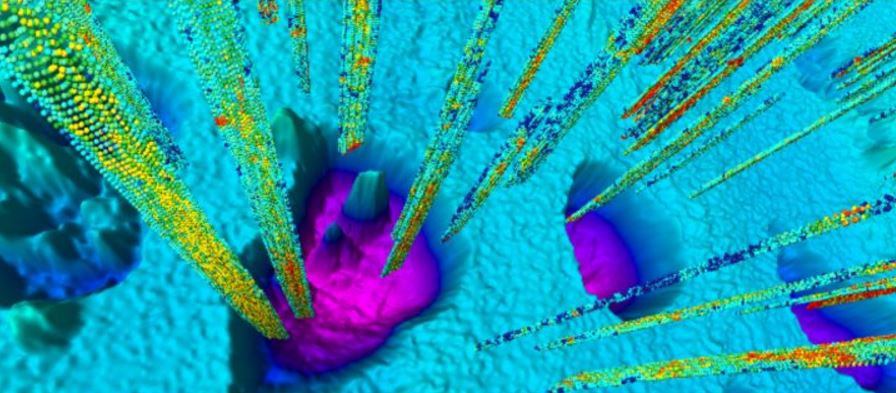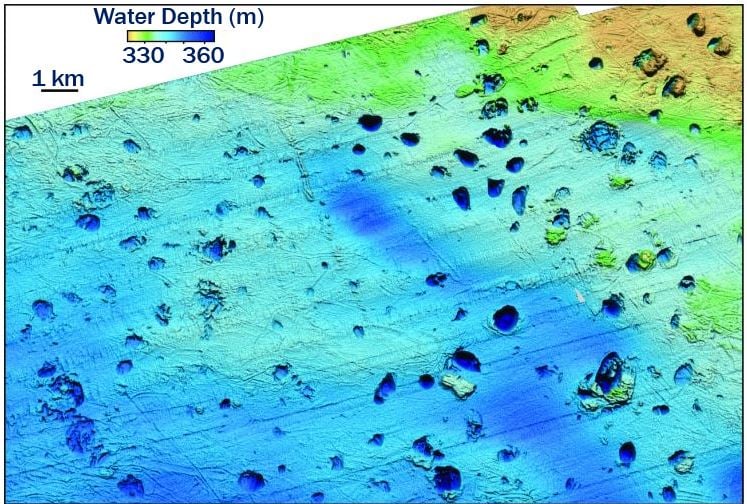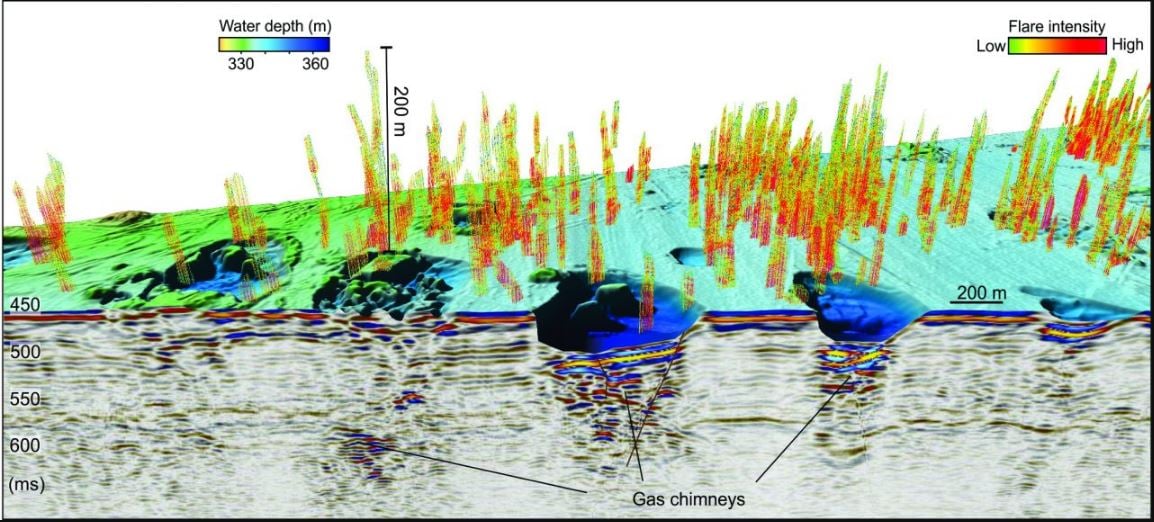Methane blowouts – trapped methane gas that breaks through the seafloor – were so powerful about 12,000 years ago that they formed huge craters on the Arctic seafloor – some of them 1 km across – says a team of Norwegian scientists. Even though the giant craters were formed all those thousands of years ago, methane continues to leak profusely from them.
Methane – along with carbon dioxide (CO2) and some others gases – is a potent greenhouse gas, and a serious global warming concern.
The researchers, from the Centre for Arctic Gas Hydrate, Environment, and Climate (CAGE), at UiT The Arctic University of Norway, and the Norwegian Petroleum Directorate, wrote about their study and findings in the journal Science, dated 2nd June, 2017, titled ‘Massive blow-out craters formed by hydrate-controlled methane expulsion from the Arctic seafloor’.
 The gigantic craters were formed about 12,000 years ago. They are still seeping methane and some other gases. (Image: cage.uit.no. Credit: Andreia Plaza Faverola)
The gigantic craters were formed about 12,000 years ago. They are still seeping methane and some other gases. (Image: cage.uit.no. Credit: Andreia Plaza Faverola)
First author, Karin Andreassen, a professor at CAGE, said:
“The crater area was covered by a thick ice sheet during the last ice age, much as West Antarctica is today. As climate warmed, and the ice sheet collapsed, enormous amounts of methane were abruptly released. This created massive craters that are still actively seeping methane.”
Over six hundred active gas flares have been identified in and round these huge craters, releasing enormous amounts of methane into the water column.
However, that is nothing compared to the methane blowouts that followed the deglaciation. “The amounts of methane that were released must have been quite impressive,” the authors wrote.
Siberian craters tiny in comparison
Some of these craters were detected for the first time in the 1990s. However, new technology shows that the craters cover a considerably larger area that had previously been thought, and provides significantly more detailed imaging for interpretation.
 There are many hundreds of craters – 100 of them up to 1km wide – in the area. (Image: cage-uit.no. Credit: K. Andreassen/CAGE)
There are many hundreds of craters – 100 of them up to 1km wide – in the area. (Image: cage-uit.no. Credit: K. Andreassen/CAGE)
Regarding the size of these giant craters, Prof. Andreassen said:
“We have focused on craters that are 300 meters to 1 kilometre wide, and have mapped approximately 100 craters of this size in the area. But there are also many hundred smaller ones, less than 300 meters wide that is.”
In comparison, two ‘huge’ blowout craters on land on Siberian peninsulas Gydan and Yamal, are fifty to ninety meters across. They were also formed as a result of methane blowouts.
Huge amounts of methane, trapped as hydrates – ice-like, solid mixtures of water and gas – exist under the Arctic seafloor. Under high pressure and very low temperatures, these hydrates are stable.
The ice sheets have always provided, and still do, ideal conditions for the formation of sub-glacial gas hydrate.
Blowouts after unbearable pressure build-up
Approximately 2,000 metres of ice loaded what is today the ocean floor with heavy weight. Methane gas from deeper hydrocarbon reservoirs made their way up, under the ice – however, they could not escape. Hydrocarbons are compounds that contain hydrogen and carbon.
The methane was stored as gas hydrate in the sediment, continuously fed by gas from below, creating conditions of over-pressure.
 Deep gas chimneys are connected to the craters. Hundreds of gas flares are seen in this image in the water above. (Image: cage.iut.no. Credit: M. Winsborrow)
Deep gas chimneys are connected to the craters. Hundreds of gas flares are seen in this image in the water above. (Image: cage.iut.no. Credit: M. Winsborrow)
Prof. Andreassen explained:
“As the ice sheet rapidly retreated, the hydrates concentrated in mounds, and eventually started to melt, expand and cause over-pressure. The principle is the same as in a pressure cooker: if you do not control the release of the pressure, it will continue to build up until there is a disaster in your kitchen.”
“These mounds were over-pressured for thousands of years, and then the lid came off. They just collapsed releasing methane into the water column.”
Did methane blowouts reach the atmosphere?
The authors write that major methane events, such as those that occurred 12,000 years ago, appear to be rare, and are therefore likely to be overlooked.
Regarding the impact of such blowouts, Prof. Andreassen said:
“Despite their infrequency, the impact of such blow-outs may still be greater than impact from slow and gradual seepage. It remains to be seen whether such abrupt and massive methane release could have reached the atmosphere.”
“We do estimate that an area of hydrocarbon reserves twice the size of Russia was directly influenced by ice sheets during past glaciation. This means that a much larger area may have had similar abrupt gas releases in the overlapping time period.”
Huge reserves of hydrocarbons exist beneath the load of the Greenland and West Antarctica ice sheets today – this is another fact to consider, the authors write.
Regarding what may happen as our ice sheets today retreat, Prof. Andreassen concluded:
“Our study provides the scientific community with a good past analogue for what may happen to future methane releases in front of contemporary, retreating ice sheets.”
In an Abstract preceding the main article in the journal, the authors wrote:
“Upon ice sheet retreat, methane from this hydrate reservoir concentrated in massive mounds before being abruptly released to form craters.”
“We propose that these processes were likely widespread across past glaciated petroleum provinces and that they also provide an analog for the potential future destabilization of subglacial gas hydrate reservoirs beneath contemporary ice sheets.”
New Science paper: Methane still leaking from ancient #craters. #climatechange @sciencemaghttps://t.co/IDZ4cFelX9
— CAGE (@CAGE_COE) June 1, 2017
